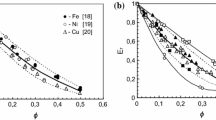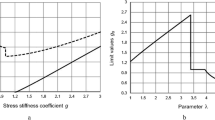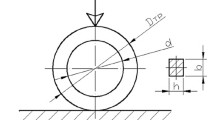Abstract
This paper is devoted to the theoretical definition of the ultimate plastic capacity for porous solids. The model is based on the assumption that ductile fracture is defined by loss of physical stability. Porosity, strain in hard phase, and decohesion are taken into account as internal variables. We suggest a method for defining the limit surface on the basis of the constitutive relations of plasticity theory for a porous solid.
Similar content being viewed by others
References
Yu. G. Dorofeev and V. V. Sinel’shchikov, “Characteristics of deformation and crack formation in heated porous semifabricates,”Poroshk. Metall., No. 1, 25–29 (1980).
Ya. E. Beigel’zimer, B. M. Éfros, V. N. Varyukhin, and A. V. Spuskanyuk, “Physical mechanics of processes of deformation and failure of materials under high pressure conditions,” in:Physics of Strength and Plasticity of Materials: Abstracts, Fourteenth International Conference (Samara, 27–30 June, 1995) [in Russian], Samara (1995), pp. 25–26.
A. V. Stepanenko, L. A. Isaevich, and V. E. Kharlan,Pressure Working of Powder Media [in Russian], Navuka i Tekhnika, Minsk (1993).
Yu. N. Podrezov, A. Yu. Koval’, and D. G. Verbilo,Preprint, Ukraine National Academy of Sciences, Institute for Problems of Materials Science; 98–7, Kiev (1998).
J. J. Burke and V. Weiss (eds.),Powder Metallurgy for High-Performance Applications [Russian translation], Metallurgiya, Moscow (1977).
M. Oyane, S. Sima, and T. Tabata, “Consideration of basic equations and their application in the forming of metal powder and porous metals,”J. Mech. Work. Technol.,1, 325–341 (1978).
A. A. Notych and E. V. Zvonarev, “Methods for evaluation of technological plasticity in pressure working of powdered metals. II. Failure criteria taking into account the stress state”,Poroshk. Metall., No. 9, 10–14 (1991).
G. A. Smirnov-Alyaev,Mechanical Principles of Plastic Working of Metals [in Russian], Mashinostroenie, Moscow/Leningrad (1968).
V. L. Kolmogorov,Stresses, Strains, and Failure [in Russian], Metallurgiya, Moscow (1970).
G. S. Pisarenko and A. A. Lebedev,Deformation and Strength of Materials for a Complex Stress State [in Russian], Nauk, Dumka, Kiev (1976).
V. A. Ogorodnikov,Assessment of Deformability of Metals in Pressure Working [in Russian], Vishcha Shk., Kiev (1983).
E. P. Unksov and A. G. Ovchinnikov (general ed.),Theory of Forging and Stamping: Textbook [in Russian], Mashinostroenie, Moscow (1992).
L. M. Kachanov,Principles of Fracture Mechanics [in Russian], Nauka, Moscow (1974).
N. A. Fleck, J. W. Hutchinson, and V. Tvergaard, “Softening by void nucleation and growth in tension and shear,”J. Mech. Phys. Sol.,37, No. 4, 515–540 (1989).
V. Tvergaard, “Material failure by void growth to coalescence,” in:Advances in Applied Mechanics, J. W. Hutchinson and T. Y. Wu (eds.), Academic Press, New York (1990), Vol. 27, pp. 83–151.
A. B. Richelsen and V. Tvergaard, Dilatant Plasticity or Upper Bound Estimates for Porous Ductile Solids, The Danish Center for Applied Mathematics and Mechanics, Lingby (1993),Report N 464, July.
R. J. Green, “A plastic theory for porous solid,”Int. J. Mech. Sci.,14, 215–224 (1972).
S. Shima and M. Oyane, “Plasticity theory for porous metals,”Int. J. Mech. Sci.,18, 16–23 (1976).
I. F. Martynova and M. B. Shtern, “Plasticity equation for a porous solid, taking into account the true strains of th base material,”Poroshk. Metall., No. 1, 23–29 (1978).
M. Abouaf and J. L. Chenot, “Numerical simulation of hot working of metal powders,”J. Mech. Theor. Appl.,5, 121 (1986).
G. L. Petrosyan, “Plasticity theory for porous solids,”Izv. Vuzov. Mashinostroenie, No. 5, 10–13 (1977).
A. M. Laptev,Izv. Vuzov. Mashinostroenie, No. 4, 153–156 (1978).
M. B. Shtern, “Model for deformation processes in compressible materials taking into account pore formation. I. Constitutive equations and the loading surface,”Poroshk. Metall., No. 5, 28–34 (1989).
M. B. Shtern, “Model of deformation processes in compressible materials taking into account pore formation. II. Uniaxial tension and compression of porous solids,”Poroshk. Metall., No. 6, 34–39 (1989).
E. Pavier and P. Doremus, “Comparison between constitutive equation modeling the compaction of iron powder and experimental data obtained with trial tests,” in:International Workshop on Modeling of Metal Powder Forming Processes (Grenoble, France, 21–23 July 1997), Grenoble (1997), pp. 1–8.
S. Shima, H. Kotera, P. Mosbah, and J. Kojima, “A study of mechanical behavior of iron powders,” in:International Workshop on Modeling of Metal Powder Forming Processes (Grenoble, France, 21–23 July 1997), Grenoble (1997), pp. 9–10.
J. Brandt and P. Lindskog, “A constitutive model for compaction of granular media with account for deformation induced anisotropy,” in:International Workshop on Modeling of Metal Powder Forming Processes (Grenoble, France, 21–23 July 1997), Grenoble (1997), pp. 41–56.
H. Ziegler,Extremal Principles of the Thermodynamics of Irreversible Processes and Mechanics of Continuous Media [author and title not verified], [Russian translation], Moscow (1966).
P. Germain,Course in Continuum Mechanics [Russian translation from French], Vyssh. Shk., Moscow (1983).
M. B. Shtern, “Development of a theory for pressing powders and a theory for the plasticity of porous solids,”Poroshk. Metall., No. 9, 12–24 (1992).
A. Cocks, “Inelastic deformation of porous materials,”J. Mech. Phys. Sol.,37, No. 6, 693–715 (1989).
M. B. Shtern, “On the constitutive potentials for porous bodies and powders,” in:Mechanics of Granular and Porous Materials, Fleck and Cocks (eds.), (1997).
V. V. Skorokhod,Rheological Principles of Sintering Theory [in Russian], Nauk. Dumka, Kiev (1972).
V. P. Katashinskii, “Localization of deformation during compaction of powders in an open volume,” in:Rheological Models and Deformation Processes in Porous Powdered and Composite Materials [in Russian], Nauk, Dumka, Kiev (1985), pp. 145–152.
P. V. Lade, “Elasto-plastic stress-strain theory for cohesionless soil with curved yield surface,”Int. J. Sol. Struct.,13, 1019–1035 (1977).
V. N. Nikolaevsky,Mechanics of Porous and Fractured Media, World Scientific, Singapore (1990).
V. Tvergaard, “Effect of yield surface curvature and void nucleation on plastic flow localization,”J. Mech. Phys. Sol. 35, No. 1, 43–91 (1987).
Additional information
Institute for Problems of Materials Science, Ukraine National Academy of Sciences, Kiev. Translated from Poroshkovaya Metallurgiya, Nos. 11–12(410), pp. 31–40, November–December, 1999.
Rights and permissions
About this article
Cite this article
Shtern, M.B., Dudunov, V.D. Determination of the ultimate plastic capacity for powder materials based on the plastic flow model for porous solids. I. Criterion for exhaustion of the ultimate plastic capacity. Powder Metall Met Ceram 38, 560–568 (1999). https://doi.org/10.1007/BF02676187
Received:
Issue Date:
DOI: https://doi.org/10.1007/BF02676187




